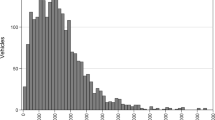Abstract
We report preliminary results on the investigation of the hypothesis of the existence of latent classes in the total demand for days out in a vast section of the Italian Eastern Alps. Finite mixing is informed by socioeconomic variables and it is limited to the demand portion of a hurdle model of visitation. Gradually more flexible count models are estimated moving from the Poisson to the Negative Binomial -1 and -2, to the generalized negative binomial. The implications for expected consumers surplus, predicted visitation and choke prices are discussed for a plausible 2 class model where years of experience play an important role in class membership.
Similar content being viewed by others
References
Cameron A, Trivedi P (1998) Regression analysis of count data. Econometrics Society Monograph, Cambridge University Press, UK
Creel MD, Loomis JB (1990) Theoretical and empirical advantages of truncated count data estimators for analysis of deer hunting in California. Am J Agric Econ 72:434–441
Grijalva T, Berrens R, Shaw W (2002) Testing the validity of contingent behaviour trip responses. Am J Agric Econ 84:401–414
Gurmu S, Trivedi P (1996) Excess zero count models for recreational trips. J Bus Econ Stat 75:469–477
Hellerstein D, Mendelsohn M (1993) A theoretical foundation for count data models, with an application to atravel cost model. Am J Agric Econ 75:604–611
Hurvich M, Tsai C (1989) Regression and time series model selection in small samples. Biometrika 76:297–307
Kamakura WA, Wedel M (1995) Lifestyle segmentation with tailored interviewing. J Mark Res 32:308–317
Langeheine R, Rost J (1988) Latent trait and latent class models. Plenum, New York
Leroux B (1992) Consistent estimation of mixing distributions. Ann Stat 20:1350–1360
McLachlan G, Peel D (2000) Finite mixture models. Wiley, New York
Morey E, Thacher J, Breffle W (2006) Using angler characteristics and attitudinal data to identify environmental preference classes: a latent-class model. Environ Resour Econ 34:91–115
Phaneuf D, Kling C, Herriges J (2000) Estimation and welfare calculations in a generalized corner solution model with an application to recreation demand. Rev Econ Stat 82:83–92
Provencher B, Barenklau K, Bishop R (2002) A finite mixture logit model of recreational angling with serially correlated random utility. Am J Agric Econ 84:1066–1075
Provencher B, Bishop R (2004) Does accounting for preference heterogeneity improve the forecasting of a random utility model? A case study. J Environ Econ Manage 48:793–810
Scarpa R, Thiene M (2005) Destination choice models for rock climbing in the Northeastern Alps: a latent-class approach based on intensity of preference. Land Econ 85(3):426–44
Shonkwiler J, Shaw W (2003) A finite mixture approach to analyzing income effects in random utility models: reservoir recreation along the Columbia river. In: Hanley N, Shaw W, Wright R (eds) The new economics of outdoor recreation. Edward Elgar, UK
Train K (1998) Recreation demand models with taste differences over people. Land Econ 74:185–194
Von Haefen RH, Phaneuf DJ (2005) Kuhn-Tucker demand system approaches to non-market valuation. In: Scarpa R, Alberini A (eds). Applications of simulation method in environmental and resource economics. Springer, Dordrecht, The Netherlands, pp 135–158
Wedel M, Kamakura WA (2000) Market segmentation: conceptual methodological foundations. Kluwer, Boston
Author information
Authors and Affiliations
Corresponding author
Rights and permissions
About this article
Cite this article
Scarpa, R., Thiene, M. & Tempesta, T. Latent class count models of total visitation demand: days out hiking in the eastern Alps . Environ Resource Econ 38, 447–460 (2007). https://doi.org/10.1007/s10640-007-9087-6
Received:
Accepted:
Published:
Issue Date:
DOI: https://doi.org/10.1007/s10640-007-9087-6
Keywords
- Travel cost method
- Latent class analysis
- Destination choice modelling
- Preference heterogeneity
- Count models




